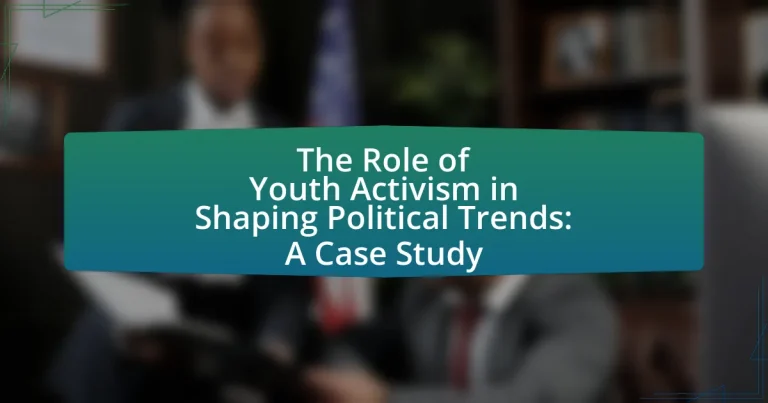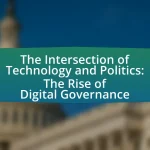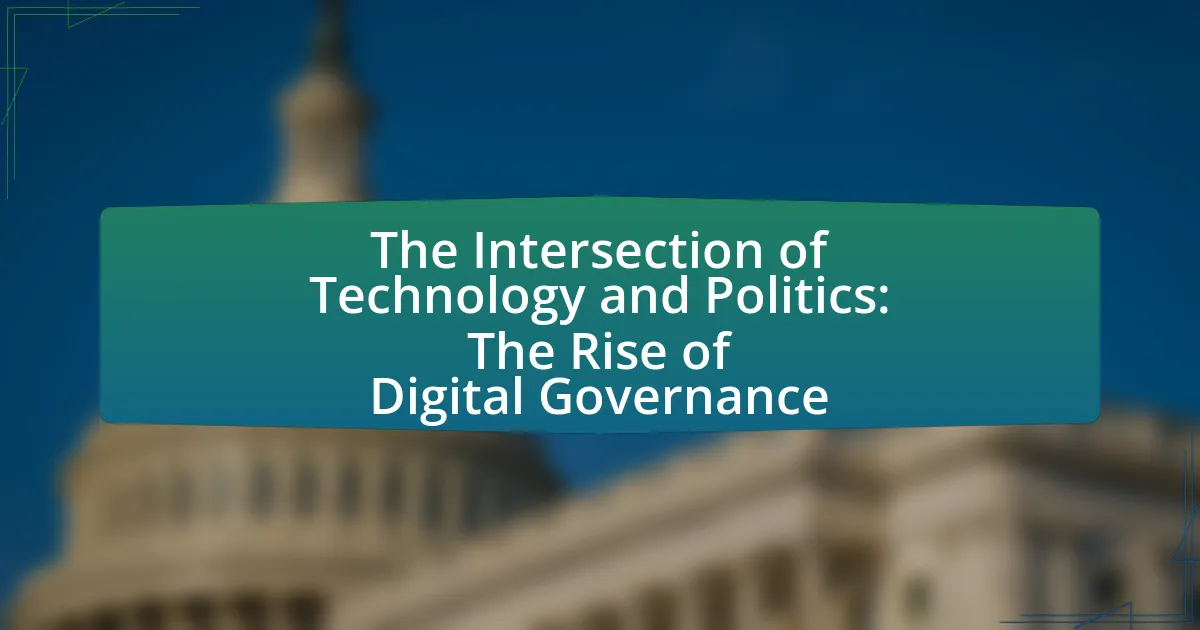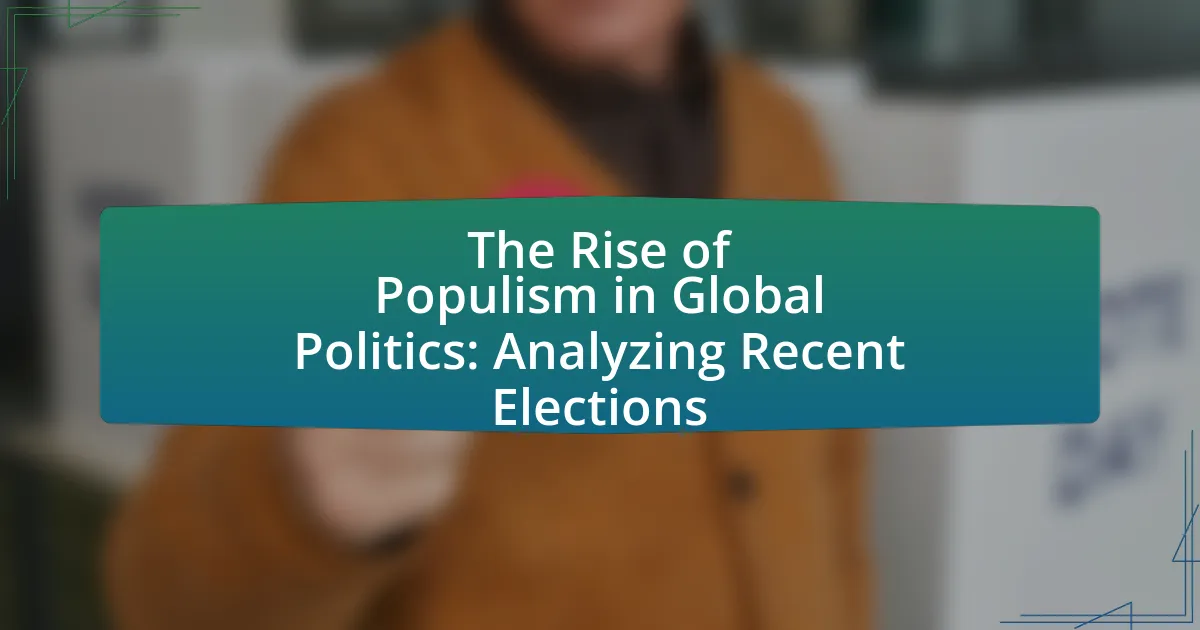Youth activism is a significant force in shaping political trends, mobilizing young individuals to advocate for social change and influence policy decisions. The article examines the historical and contemporary impact of youth-led movements, such as the March for Our Lives and climate strikes initiated by Greta Thunberg, highlighting their role in driving discussions on critical issues like gun control and climate change. It also explores the challenges faced by young activists, including systemic barriers and societal perceptions, while emphasizing the importance of diversity and intersectionality in activism. Additionally, the article discusses how educational institutions and grassroots movements empower youth, ultimately illustrating the profound influence of youth activism on political discourse and policy-making.
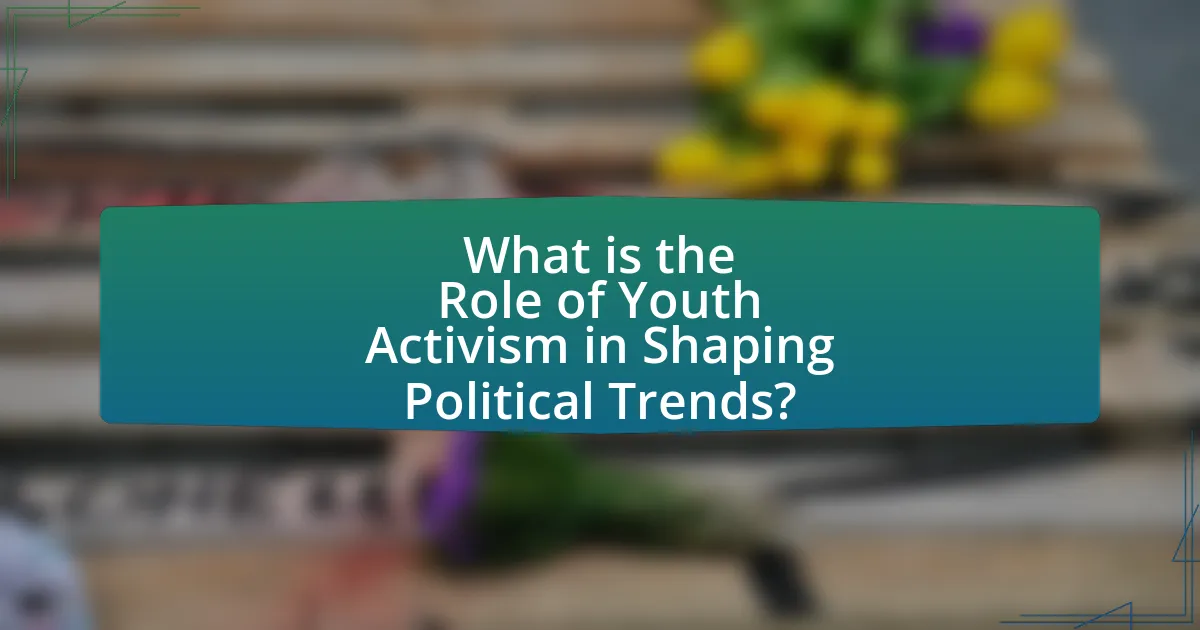
What is the Role of Youth Activism in Shaping Political Trends?
Youth activism plays a crucial role in shaping political trends by mobilizing young people to advocate for social change and influence policy decisions. This demographic often drives movements related to climate change, racial justice, and education reform, as evidenced by the global impact of initiatives like the March for Our Lives and the Fridays for Future climate strikes. Research indicates that youth-led movements can significantly sway public opinion and political agendas, with studies showing that 70% of young activists believe their efforts can lead to tangible change. Furthermore, the rise of social media has amplified their voices, allowing for rapid dissemination of ideas and organization of protests, thereby reinforcing their influence on political discourse.
How has youth activism historically influenced political movements?
Youth activism has historically influenced political movements by mobilizing large groups of young people to advocate for social change, often leading to significant political reforms. For instance, during the Civil Rights Movement in the 1960s, youth-led organizations like the Student Nonviolent Coordinating Committee (SNCC) played a crucial role in organizing protests and sit-ins, which were pivotal in challenging racial segregation and discrimination. Additionally, the anti-Vietnam War protests in the late 1960s saw widespread participation from college students, which pressured the U.S. government to reconsider its military involvement in Vietnam. These examples illustrate how youth activism has not only raised awareness about critical issues but also catalyzed legislative changes and shifted public opinion, demonstrating its lasting impact on political landscapes.
What key events exemplify youth activism’s impact on politics?
Key events that exemplify youth activism’s impact on politics include the March for Our Lives in 2018, which was organized by students from Stoneman Douglas High School following a mass shooting, leading to significant discussions on gun control legislation. Another pivotal event is the global climate strikes initiated by Greta Thunberg, which mobilized millions of young people worldwide to demand action on climate change, influencing political agendas and policies in various countries. Additionally, the Black Lives Matter movement, particularly the protests in 2020 following the death of George Floyd, saw substantial youth participation, resulting in widespread calls for police reform and racial justice, impacting local and national policies. These events demonstrate how youth activism can drive political change and shape public discourse.
How do historical contexts shape youth activism’s effectiveness?
Historical contexts significantly shape youth activism’s effectiveness by influencing the political, social, and economic environments in which young activists operate. For instance, during the Civil Rights Movement in the 1960s, the pervasive racial discrimination and the urgency for social justice galvanized youth participation, leading to impactful actions such as sit-ins and marches that directly challenged systemic racism. Similarly, the rise of digital technology in the 21st century has transformed youth activism, enabling rapid mobilization and global outreach, as seen in movements like Black Lives Matter and climate strikes initiated by young activists. These historical contexts provide the framework within which youth activism can either thrive or struggle, as they dictate the level of societal support, the presence of oppressive regimes, and the availability of resources for organizing and advocacy.
Why is youth activism crucial in contemporary political landscapes?
Youth activism is crucial in contemporary political landscapes because it mobilizes young people to advocate for social change and influence policy decisions. This demographic, often characterized by their engagement in issues like climate change, racial justice, and education reform, brings fresh perspectives and innovative solutions to longstanding problems. For instance, the global climate strikes initiated by youth activists, such as Greta Thunberg, have significantly raised awareness and pressured governments to adopt more aggressive climate policies. Additionally, studies show that youth participation in political movements can lead to increased voter turnout and engagement in democratic processes, as evidenced by the rise in youth voter participation in the 2020 U.S. elections, where 50% of eligible voters aged 18-29 cast their ballots, a significant increase from previous years. Thus, youth activism not only shapes political discourse but also drives tangible changes in policy and civic engagement.
What unique perspectives do young activists bring to political discourse?
Young activists bring fresh, innovative perspectives to political discourse by prioritizing issues such as climate change, social justice, and equity. Their engagement often reflects a deep understanding of the interconnectedness of global challenges, as evidenced by movements like Fridays for Future, which mobilized millions to advocate for urgent climate action. Additionally, young activists leverage digital platforms to amplify their voices, creating inclusive spaces for dialogue and fostering grassroots movements that challenge traditional political structures. This generational shift in activism not only highlights the urgency of contemporary issues but also emphasizes the importance of diverse viewpoints in shaping effective policy solutions.
How does social media amplify youth activism’s reach and influence?
Social media amplifies youth activism’s reach and influence by providing a platform for rapid information dissemination and community building. Through platforms like Twitter, Instagram, and TikTok, young activists can share their messages widely, mobilizing support and raising awareness on issues such as climate change, racial justice, and gender equality. For instance, the #FridaysForFuture movement, initiated by Greta Thunberg, gained global traction through social media, leading to millions participating in climate strikes worldwide. This demonstrates that social media not only facilitates the spread of ideas but also fosters a sense of solidarity among youth, enabling them to organize events and campaigns effectively.
What challenges do youth activists face in shaping political trends?
Youth activists face significant challenges in shaping political trends, including systemic barriers, lack of resources, and generational divides. Systemic barriers often manifest as institutional resistance to change, where established political entities may dismiss or undermine youth perspectives. For instance, a study by the Pew Research Center in 2020 highlighted that only 27% of young people felt their voices were heard in political discussions, indicating a disconnect between youth activism and political responsiveness. Additionally, youth activists frequently encounter limited access to funding and organizational support, which hampers their ability to mobilize effectively. The generational divide further complicates their efforts, as older political leaders may not prioritize issues that resonate with younger demographics, such as climate change or social justice. This disconnect can lead to frustration and disengagement among youth activists, ultimately impacting their influence on political trends.
How do societal perceptions affect the legitimacy of youth activism?
Societal perceptions significantly influence the legitimacy of youth activism by shaping public opinion and acceptance of their causes. When society views youth activism as credible and aligned with broader social values, it enhances the perceived legitimacy of these movements, leading to increased support and engagement. For instance, the global response to climate change activism, particularly the efforts led by figures like Greta Thunberg, demonstrates how positive societal perceptions can mobilize widespread action and policy discussions. Conversely, negative perceptions, often rooted in stereotypes about youth being uninformed or overly emotional, can undermine their efforts and diminish their impact. Research indicates that youth-led movements that resonate with established societal norms and values tend to gain more traction and legitimacy, as seen in various historical contexts where youth activism has successfully influenced political change.
What barriers do young activists encounter in political engagement?
Young activists encounter several barriers in political engagement, including lack of access to resources, limited political experience, and systemic disenfranchisement. These barriers hinder their ability to participate effectively in political processes. For instance, a study by the Center for Information & Research on Civic Learning and Engagement (CIRCLE) found that young people often face financial constraints that limit their ability to engage in activism, such as attending events or organizing campaigns. Additionally, many young activists report feeling marginalized within political discussions, which can discourage their participation. Furthermore, legal and institutional obstacles, such as age restrictions on voting and limited representation in decision-making bodies, further complicate their efforts to influence political outcomes.
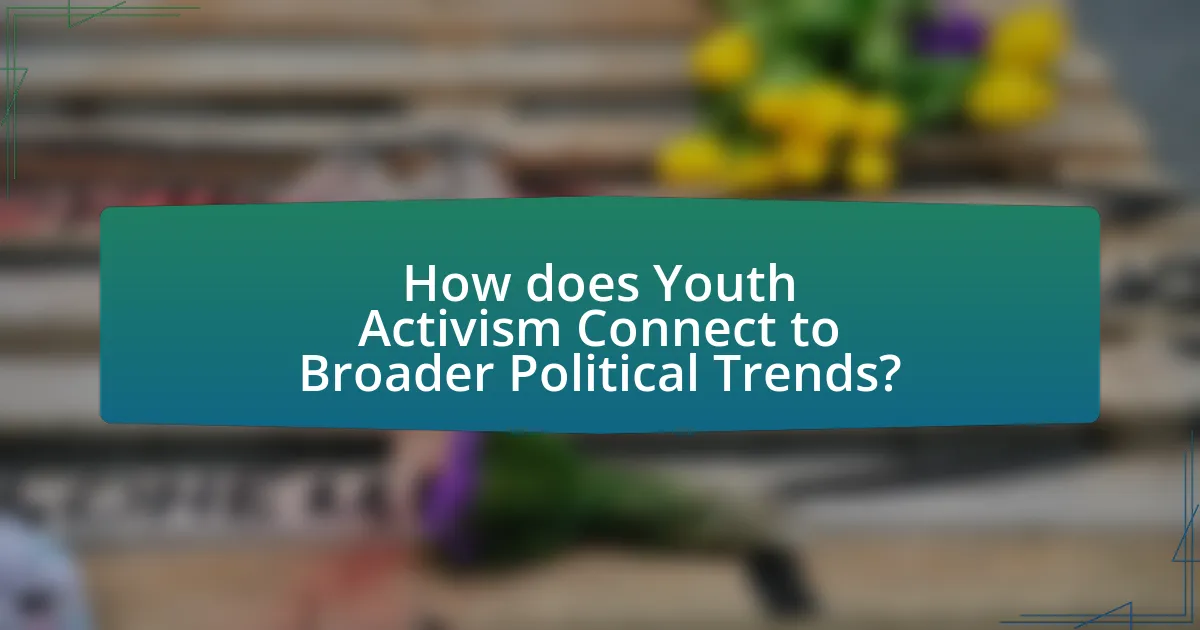
How does Youth Activism Connect to Broader Political Trends?
Youth activism connects to broader political trends by serving as a catalyst for social change and influencing policy decisions. Historically, movements led by young people, such as the civil rights movement in the 1960s and more recently, the climate strikes initiated by Greta Thunberg, have highlighted urgent issues and mobilized public opinion. These movements often reflect and amplify existing political sentiments, such as demands for justice, equality, and environmental sustainability, thereby shaping the political landscape. For instance, the rise of youth-led organizations has been linked to increased voter turnout among younger demographics, as seen in the 2020 U.S. elections, where youth participation reached 50%, significantly impacting election outcomes.
What role does intersectionality play in youth activism?
Intersectionality plays a crucial role in youth activism by highlighting how various social identities, such as race, gender, sexuality, and class, intersect to create unique experiences of oppression and privilege. This framework enables young activists to understand and address the multifaceted nature of social injustices, ensuring that their movements are inclusive and representative of diverse voices. For instance, the Black Lives Matter movement incorporates intersectional perspectives by addressing not only police violence but also issues like economic inequality and gender discrimination, thereby broadening the scope and impact of youth-led initiatives. Research by Crenshaw (1989) emphasizes that without an intersectional approach, activism may overlook the specific needs of marginalized groups, ultimately weakening the effectiveness of social movements.
How do various social movements intersect with youth activism?
Various social movements intersect with youth activism by providing a platform for young people to engage in collective action and advocacy for social change. Youth activism often aligns with movements such as climate justice, racial equality, and gender rights, where young individuals mobilize to address systemic issues. For instance, the global climate strikes led by youth activists like Greta Thunberg exemplify how environmental movements harness the energy and urgency of young voices to demand policy changes. Additionally, the Black Lives Matter movement has seen significant youth involvement, with young activists playing crucial roles in protests and online campaigns to combat racial injustice. These intersections highlight the ability of youth to influence political discourse and drive social movements forward, as evidenced by the increased visibility and impact of these issues in mainstream media and policy discussions.
What impact does diversity within youth activism have on political outcomes?
Diversity within youth activism significantly enhances political outcomes by fostering a broader range of perspectives and solutions to societal issues. When youth activists represent various backgrounds, including race, gender, socioeconomic status, and geographic location, they can address the needs and concerns of a wider demographic, leading to more inclusive policy proposals. For instance, the 2018 March for Our Lives movement, which included diverse voices advocating for gun control, resulted in increased legislative attention to gun safety laws across multiple states. This illustrates how diverse youth activism can mobilize support and influence political agendas, ultimately leading to tangible changes in legislation and public policy.
How do educational institutions influence youth activism?
Educational institutions influence youth activism by providing a platform for critical thinking, civic engagement, and social awareness. Schools and universities often incorporate curricula that address social issues, encouraging students to engage in discussions and activism related to topics such as climate change, racial equality, and human rights. For instance, the integration of service-learning programs and extracurricular activities focused on social justice fosters a sense of responsibility and empowerment among students. Research indicates that students involved in such programs are more likely to participate in activism, as evidenced by the increased youth participation in movements like the March for Our Lives and climate strikes initiated by students globally. These institutions not only educate but also mobilize youth, equipping them with the skills and knowledge necessary to advocate for change.
What programs or initiatives support youth political engagement in schools?
Programs and initiatives that support youth political engagement in schools include the Junior State of America, which fosters civic engagement through student-led debates and conferences, and the Close Up Foundation, which provides experiential learning opportunities in Washington, D.C. Additionally, the National Youth Leadership Council promotes service-learning projects that encourage students to engage with their communities and understand civic responsibilities. These programs have been shown to increase political awareness and participation among youth, as evidenced by studies indicating that students involved in such initiatives are more likely to vote and engage in civic activities as adults.
How do universities serve as incubators for political activism?
Universities serve as incubators for political activism by providing a platform for students to engage in discourse, organize movements, and develop leadership skills. The academic environment fosters critical thinking and encourages students to question societal norms, which often leads to collective action on issues such as civil rights, climate change, and social justice. Historical examples include the role of universities during the Civil Rights Movement, where student-led organizations like SNCC emerged, mobilizing youth to advocate for racial equality. Additionally, research indicates that campuses often host events, workshops, and discussions that empower students to become politically active, further solidifying their role as breeding grounds for activism.

What are the Specific Case Studies of Youth Activism Impacting Political Trends?
Specific case studies of youth activism impacting political trends include the March for Our Lives movement, which emerged after the 2018 Parkland school shooting, advocating for gun control and resulting in significant legislative discussions across various states. Another example is the Fridays for Future movement, initiated by Greta Thunberg, which mobilized millions of young people globally to demand action on climate change, influencing political agendas and policies in numerous countries. Additionally, the Black Lives Matter movement, which gained momentum through youth-led protests following the murder of George Floyd in 2020, has reshaped discussions around racial justice and police reform in the United States. These case studies demonstrate how organized youth activism can lead to substantial shifts in political discourse and policy-making.
What are notable examples of youth-led movements in recent history?
Notable examples of youth-led movements in recent history include the March for Our Lives, initiated by students from Stoneman Douglas High School in 2018, advocating for gun control in the United States. This movement gained significant traction, mobilizing over 800,000 participants in a Washington, D.C. rally and influencing legislative discussions on gun reform. Another example is the Fridays for Future movement, started by Greta Thunberg in 2018, which has inspired millions of young people globally to demand action on climate change, resulting in widespread climate strikes and increased awareness of environmental issues. Additionally, the Black Lives Matter movement, which has seen substantial youth involvement, particularly during the protests following George Floyd’s death in 2020, has played a crucial role in addressing systemic racism and police brutality, leading to policy discussions and reforms in various cities. These movements demonstrate the significant impact of youth activism on political trends and societal change.
How did the March for Our Lives movement shape gun control debates?
The March for Our Lives movement significantly shaped gun control debates by mobilizing youth activism and bringing national attention to gun violence issues. This movement, initiated by survivors of the 2018 Parkland shooting, organized a massive rally in Washington, D.C., attracting over 800,000 participants and inspiring similar events worldwide. The movement’s emphasis on legislative change led to increased public discourse on gun control, influencing lawmakers to consider measures such as universal background checks and assault weapon bans. Polls conducted after the march indicated a rise in public support for stricter gun laws, demonstrating the movement’s impact on shifting public opinion and political priorities regarding gun control.
What lessons can be learned from the climate strikes initiated by youth activists?
The climate strikes initiated by youth activists demonstrate the power of collective action and the effectiveness of grassroots movements in influencing political discourse. These strikes have mobilized millions globally, highlighting the urgency of climate change and pressuring governments to take action. For instance, the Global Climate Strike on September 20, 2019, saw an estimated 4 million participants worldwide, showcasing the ability of youth to galvanize public support and media attention. Additionally, these movements emphasize the importance of intergenerational equity, as young activists advocate for policies that ensure a sustainable future for their generation and beyond. The strikes also illustrate the role of social media in organizing and amplifying messages, enabling rapid dissemination of information and fostering a sense of community among activists.
How do local youth activism efforts contribute to national political trends?
Local youth activism efforts significantly influence national political trends by mobilizing young voters and shaping public discourse. For instance, movements like Black Lives Matter, which began at a local level, have sparked nationwide conversations about racial justice and police reform, leading to policy changes in various states. Additionally, youth-led initiatives, such as climate strikes organized by groups like Fridays for Future, have raised awareness about environmental issues, prompting national political leaders to prioritize climate action in their agendas. These local efforts often utilize social media to amplify their messages, creating a ripple effect that resonates across the country, thereby aligning local activism with broader national movements and influencing electoral outcomes.
What strategies have local youth organizations employed to influence policy?
Local youth organizations have employed strategies such as grassroots mobilization, advocacy campaigns, and coalition-building to influence policy. Grassroots mobilization involves organizing community members to participate in demonstrations and public forums, effectively raising awareness and pressuring policymakers. Advocacy campaigns utilize social media and traditional media to disseminate information and engage the public on specific issues, thereby shaping public opinion and influencing legislative agendas. Coalition-building allows youth organizations to collaborate with other groups, amplifying their voices and creating a united front that can more effectively lobby for policy changes. For instance, the Youth Climate Strike movement successfully mobilized thousands of young people globally, leading to increased political attention on climate policies.
How do grassroots movements empower young activists in their communities?
Grassroots movements empower young activists in their communities by providing them with a platform for collective action and fostering a sense of agency. These movements often emphasize local issues, enabling youth to engage directly with their communities and influence decision-making processes. For instance, the Black Lives Matter movement has mobilized young activists to address systemic racism and police violence, demonstrating how grassroots initiatives can amplify youth voices and drive social change. Additionally, research from the Harvard Kennedy School indicates that youth involvement in grassroots movements leads to increased civic engagement and political participation, reinforcing the impact of these movements on empowering young activists.
What practical steps can young activists take to enhance their political impact?
Young activists can enhance their political impact by organizing grassroots campaigns that mobilize community support and raise awareness on critical issues. Effective grassroots campaigns have been shown to increase voter turnout; for example, the 2018 midterm elections in the United States saw a significant rise in youth voter participation, largely driven by organized efforts from young activists. Additionally, young activists should leverage social media platforms to disseminate information rapidly and engage a broader audience, as studies indicate that social media can amplify messages and foster community engagement. Collaborating with established organizations can also provide resources and networks that amplify their efforts, as seen in various successful movements where youth partnered with larger advocacy groups to achieve legislative change.
